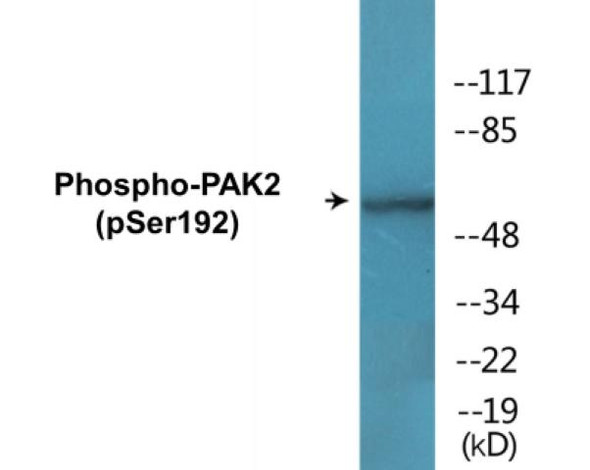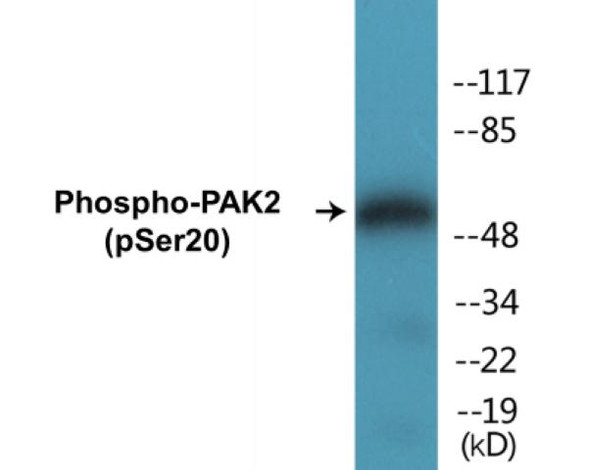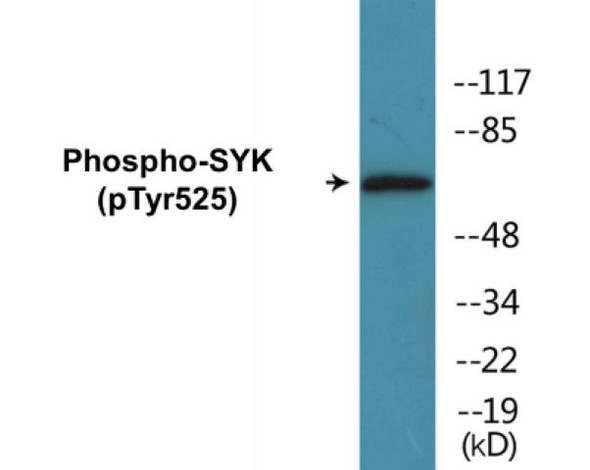Description
PAK2 (Phospho-Ser141) Cell-Based ELISA Kit
The PAK2 (Phospho-Ser141) Cell-Based ELISA Kit is a convenient, lysate- free, high throughput and sensitive assay kit that can monitor PAK2 phosphorylation and expression profile in cells. The kit can be used for measuring the relative amounts of phosphorylated PAK2 in cultured cells as well as screening for the effects that various treatments, inhibitors (ie. siRNA or chemicals), or activators have on PAK2 phosphorylation.
How does our PAK2 (Phospho-Ser141) Fluorometric Cell-Based ELISA Kit work?
Qualitative determination of PAK2 (Phospho-Ser141) concentration is achieved by an indirect ELISA format. In essence, PAK2 (Phospho-Ser141) is captured by PAK2 (Phospho-Ser141)-specific primary (1°) antibodies while Dye 1-conjugated and Dye 2-conjugated secondary (2°) antibodies bind the Fc region of the 1° antibody. Through this binding, the dye conjugated to the 2° antibody can emit light at a certain wavelength given proper excitation, hence allowing for a fluorometric detection method. Due to the qualitative nature of the Cell-Based ELISA, multiple normalization methods are needed:
| 1. | A monoclonal antibody specific for human GAPDH is included to serve as an internal positive control in normalizing the target RFU values. |
| 2. | An antibody against the nonphosphorylated counterpart of PAK2 (Phospho-Ser141) is also provided for normalization purposes. The RFU values obtained for non-phosphorylated PAK2 can be used to normalize the RFU value for phosphorylated PAK2. |
PAK2 (Phospho-Ser141) Fluorometric Cell-Based ELISA Kit -Information
| Product Name: | PAK2 (Phospho-Ser141)Fluorometric Cell-Based ELISA Kit |
| Product Code/SKU: | FBCAB00090 |
| Description: | The PAK2 (Phospho-Ser141) Fluorometric Cell-Based Phospho ELISA Kit is a convenient, lysate-free, high throughput and sensitive assay kit that can monitor PAK2 (Phospho-Ser141) protein phosphorylation and expression profile in cells. The kit can be used for measuring the relative amounts of phosphorylated PAK2 (Phospho-Ser141) in cultured cells as well as screening for the effects that various treatments, inhibitors (ie. siRNA or chemicals, or activators have on PAK2 phosphorylation. |
| Dynamic Range: | > 5000 Cells |
| Detection Method: | Fluorometric |
| Storage/Stability: | 4°C/6 Months |
| Reactivity: | Human, Mouse, Rat |
| Assay Type: | Cell-Based ELISA |
| Database Links: | Gene ID: 5062, UniProt ID: Q13177, OMIM #: 605022, Unigene #: Hs.518530 |
| Format: | Two 96-Well Plates |
| NCBI Gene Symbol: | PAK2 |
| Sub Type: | Phospho |
| Target Name: | Phospho-PAK2 (Ser141) |
Kit Principle
Figure: Schematic representation of Assay Genie Cell-Based Fluorometric ELISA principle
Kit components | Quantity |
| 96-Well Black Cell CultureClear-Bottom Microplate | 2 plates |
| 10X TBS | 24 ml |
| Quenching Buffer | 24 ml |
| Blocking Buffer | 50 ml |
| 15X Wash Buffer | 50 ml |
| Primary Antibody Diluent | 12 ml |
| 100x Anti-Phospho Target Antibody | 60 µl |
| 100x Anti-Target Antibody | 60 µl |
| Anti-GAPDH Antibody | 110 µl |
| Dye-1 Conjugated Anti-Rabbit IgG Antibody | 6 ml |
| Dye-2 Conjugated Anti-Mouse IgG Antibody | 6 ml |
| Adhesive Plate Seals | 2 seals |
Additional equipment and materials required
The following materials and/or equipment are NOT provided in this kit but are necessary to successfully conduct the experiment:
- Fluorescent plate reader with two channels at Ex/Em: 651/667 and 495/521
- Micropipettes capable of measuring volumes from 1 µl to 1 ml
- Deionized or sterile water (ddH2O)
- 37% formaldehyde (Sigma Cat# F-8775) or formaldehyde from other sources
- Squirt bottle, manifold dispenser, multichannel pipette reservoir or automated microplate washer
- Graph paper or computer software capable of generating or displaying logarithmic functions
- Absorbent papers or vacuum aspirator
- Test tubes or microfuge tubes capable of storing ≥1 ml
- Poly-L-Lysine (Sigma Cat# P4832 for suspension cells)
- Orbital shaker (optional)
Kit Protocol
This is a summarized version of the kit protocol. Please view the technical manual of this kit for information on sample preparation, reagent preparation and plate lay out.
| 1. | Seed 200 µl of desired cell concentration in culture medium into each well of the 96-well plates. For suspension cells and loosely attached cells, coat the plates with 100 µl of 10 µg/ml Poly-L-Lysine (not included) to each well of a 96-well plate for 30 minutes at 37°C prior to adding cells. |
| 2. | Incubate the cells for overnight at 37°C, 5% CO2. |
| 3. | Treat the cells as desired. |
| 4. | Remove the cell culture medium and rinse with 200 µl of 1x TBS, twice. |
| 5. | Fix the cells by incubating with 100 µl of Fixing Solution for 20 minutes at room temperature. The 4% formaldehyde is used for adherent cells and 8% formaldehyde is used for suspension cells and loosely attached cells. |
| 6. | Remove the Fixing Solution and wash the plate 3 times with 200 µl 1x Wash Buffer for 3 minutes. The plate can be stored at 4°C for a week. |
| 7. | Add 100 µl of Quenching Buffer and incubate for 20 minutes at room temperature. |
| 8. | Wash the plate 3 times with 1x Wash Buffer for 3 minutes each time. |
| 9. | Dispense 200 µl of Blocking Buffer and incubate for 1 hour at room temperature. |
| 10. | Wash 3 times with 200 µl of 1x Wash Buffer for 3 minutes each time. |
| 11. | Add 50 µl of Primary Antibody Mixture P to corresponding wells for PAK2 (Phospho-Ser141) detection. Add 50 µl of Primary Antibody Mixture NP to the corresponding wells for total PAK2 detection. Cover the plate with parafilm and incubate for 16 hours (overnight) at 4°C. If the target expression is known to be high, incubate for 2 hours at room temperature. |
| 12. | Wash 3 times with 200 µl of 1x Wash Buffer for 3 minutes each time. |
| 13. | Add 50 ul of Secondary Antibody Mixture to corresponding wells and incubate for 1.5 hours at room temperature in the dark. |
| 14. | Wash 3 times with 200 µl of 1x Wash Buffer for 3 minutes each time. |
| 15. | Read the plate(s) at Ex/Em: 651/667 (Dye 1) and 495/521 (Dye 2). Shield plates from direct light exposure. |
| 16. | Wash 3 times with 200 µl of 1x Wash Buffer for 5 minutes each time. |
PAK2 (Phospho-Ser141) - Protein Information
| UniProt Protein Function: | PAK2: a protein kinase of the STE20 family. Critical effector linking RhoGTPases to cytoskeleton reorganization and nuclear signaling. Activated by proteolytic cleavage during caspase-mediated apoptosis, and may play a role in regulating the apoptotic events in the dying cell. |
| UniProt Protein Details: | Protein type:Protein kinase, Ser/Thr (non-receptor); EC 2.7.11.1; Protein kinase, STE; Kinase, protein; STE group; STE20 family; PAKA subfamily Chromosomal Location of Human Ortholog: 3q29 Cellular Component: cytoplasm; cytosol; nucleoplasm; perinuclear region of cytoplasm; plasma membrane Molecular Function:ATP binding; identical protein binding; protein binding; protein kinase activity; protein kinase binding; protein serine/threonine kinase activity; protein tyrosine kinase activator activity; Rac GTPase binding Biological Process: actin cytoskeleton organization and biogenesis; apoptosis; axon guidance; cell migration; cell structure disassembly during apoptosis; innate immune response; negative regulation of apoptosis; negative regulation of protein kinase activity; peptidyl-serine phosphorylation; phosphorylation; positive regulation of peptidyl-tyrosine phosphorylation; programmed cell death; protein amino acid autophosphorylation; protein amino acid phosphorylation; regulation of apoptosis; regulation of defense response to virus by virus; regulation of growth; regulation of MAPKKK cascade; regulation of mitotic cell cycle; Rho protein signal transduction; signal transduction; small GTPase mediated signal transduction; stimulatory C-type lectin receptor signaling pathway; stress-activated protein kinase signaling pathway; T cell costimulation; T cell receptor signaling pathway; vascular endothelial growth factor receptor signaling pathway; viral reproduction |
| NCBI Summary: | The p21 activated kinases (PAK) are critical effectors that link Rho GTPases to cytoskeleton reorganization and nuclear signaling. The PAK proteins are a family of serine/threonine kinases that serve as targets for the small GTP binding proteins, CDC42 and RAC1, and have been implicated in a wide range of biological activities. The protein encoded by this gene is activated by proteolytic cleavage during caspase-mediated apoptosis, and may play a role in regulating the apoptotic events in the dying cell. [provided by RefSeq, Jul 2008] |
| UniProt Code: | Q13177 |
| NCBI GenInfo Identifier: | 143811432 |
| NCBI Gene ID: | 5062 |
| NCBI Accession: | Q13177.3 |
| UniProt Secondary Accession: | Q13177,Q13154, Q6ISC3, |
| UniProt Related Accession: | Q13177 |
| Molecular Weight: | |
| NCBI Full Name: | Serine/threonine-protein kinase PAK 2 |
| NCBI Synonym Full Names: | p21 protein (Cdc42/Rac)-activated kinase 2 |
| NCBI Official Symbol: | PAK2 |
| NCBI Official Synonym Symbols: | PAK65; PAKgamma |
| NCBI Protein Information: | serine/threonine-protein kinase PAK 2 |
| UniProt Protein Name: | Serine/threonine-protein kinase PAK 2 |
| UniProt Synonym Protein Names: | Gamma-PAK; PAK65; S6/H4 kinase; p21-activated kinase 2; PAK-2 |
| Protein Family: | Serine/threonine-protein kinase |
| UniProt Gene Name: | PAK2 |
| UniProt Entry Name: | PAK2_HUMAN |







